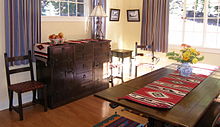- Crater Lake Superintendent's Residence
-
Crater Lake Superintendent's Residence

Location: Crater Lake National Park, Oregon Nearest city: Fort Klamath, Oregon Coordinates: 42°54′00.75″N 122°08′14.60″W / 42.9002083°N 122.137389°W Built: 1932[1] Architect: NPS Branch of Plans & Design, et al..[2] Architectural style: National Park Service rustic[citation needed] Governing body: National Park Service NRHP Reference#: 87001347[1] Significant dates Added to NRHP: May 28, 1987[1] Designated NHL: May 28, 1987[3] Crater Lake Superintendent's Residence, is "an impressive structure of massive boulders and heavy-handed woodwork" at Crater Lake National Park[4] in southern Oregon. It was declared a National Historic Landmark in 1987.[3][4][5]
The park Superintendent's Residence is located at north end of Munson Valley Historic District (NRHP #88002622). It was constructed in 1933. The building’s footprint is 33 by 61 feet with a rustic stone superstructure and wood-shake roof. The first floor includes an entry hall, living room with lava-rock fireplace, a dining room, kitchen, and bedroom with adjoining bathroom. The second floor has four additional bedrooms and two bathrooms. The building was framed in Douglas fir and the roof covered with cedar shakes.[6]
Today, the building houses part of the park’s Science and Learning Center. It opened its doors on August 26, 2006. [7] The Superintendent's House was completely restored and retrofitted for safety in order to become useful once more to serve scientists and students in studies pertaining to Crater Lake and the surrounding area. The main house is used as library, meeting space, and offices and is furnished with the original Imperial Monterey furniture. An adjacent secondary building serves as a bunkhouse for visitors, and houses a mixture of reproduction and original Imperial Monterey furniture. The reproduction furniture was created as part of a graduate student project by two students from the Oregon College of Art and Craft.
The Imperial Monterey furniture line conserved for Crater Lake National Park was purchased by the NPS through Meier & Frank in Portland, Oregon. It is one of two largest complete lines known in existence in a public place, the other being a line of Mason Monterey furniture just a few hours away at the Oregon Caves National Monument. The Imperial furniture line is one of the best known of the secondary Monterey lines, made in Los Angeles, California in the early 1930’s. The Imperial line utilized mahogany as their primary wood, usually stained dark brown with a silvery sheen, created by grain filler, probably silex or calcium chloride. The line was solid and heavy, accented by top quality ironwork. Originally the line was upholstered in a multicolored cotton weave in a fiesta-influenced pattern. The restoration show covers chosen were rich red and cordovan colored waxed top grain aniline leathers, which was also appropriate to the time. [8]
See also
References
- ^ a b c Oregon Parks and Recreation Department (2007-07-16). "Oregon National Register List". http://www.oregonheritage.org/OPRD/HCD/NATREG/docs/oregon_nr_list.pdf. Retrieved 2008-03-29
- ^ National Park Service. "National Register Information System". http://www.cr.nps.gov/NR/research/nris.htm. Retrieved 2008-03-29.
- ^ a b National Park Service. "National Historic Landmark Program: NHL Database". http://tps.cr.nps.gov/nhl/default.cfm. Retrieved 2007-11-18.
- ^ a b ""Architecture in the Parks: A National Historic Landmark Theme Study: Crater Lake Superintendent's Residence", by Laura Soullière Harrison". National Historic Landmark Theme Study. National Park Service. http://www.nps.gov/history/history/online_books/harrison/harrison22.htm. Retrieved 2007-11-18.
- ^ Laura Soullière Harrison (1985). National Register of Historic Places Inventory-Nomination: Superintendent's Residence / Former Superintendent's ResidencePDF (382 KB). National Park Service and Accompanying 10 photos, exterior and interior, from 1985.PDF (1.83 MB)
- ^ Green, Linda W., "Construction of Government Buildings and Landscaping in Crater Lake National Park", Crater Lake Historic Resource Study, National Park Service, United States Department of the Interior, Denver, Colorado, June 1984.
- ^ "Munson Valley Historic District", Crater Lake National Park Trust, Crater Lake, Oregon, 8 April 2008.
- ^ Treatment Reports for the Conservation of the Imperial Monterey Furniture, Crater lake National Park's Science and Learning Center, 2006[1]
External links
- Crater Lake National Park
- Architecture in the Parks: A National Historic Landmark Theme Study: Superintendent's Residence, by Laura Soullière Harrison, 1986, at National Park Service.
- [2] Documentation about the restoration and conservation of the furniture in the Superintendent's Residence.
Crater Lake Natural places Man-made places Comfort Station No. 68 • Comfort Station No. 72 • Crater Lake Lodge • Crater Lake Superintendent's Residence • Sinnott Memorial Observation Station • Watchman Lookout StationPeople Designated areas U.S. National Register of Historic Places in Oregon Lists by county Baker • Benton • Clackamas • Clatsop • Columbia • Coos • Crook • Curry • Deschutes • Douglas • Gilliam • Grant • Harney • Hood River • Jackson • Jefferson • Josephine • Klamath • Lake • Lane • Lincoln • Linn • Malheur • Marion • Morrow • Multnomah: Portland North • Multnomah: Portland Northeast • Multnomah: Portland Northwest • Multnomah: Portland Southeast • Multnomah: Portland Southwest • Multnomah: Other • Polk • Sherman • Tillamook • Umatilla • Union • Wallowa • Wasco • Washington • Wheeler • Yamhill

Other lists Keeper of the Register • History of the National Register of Historic Places • Property types • Historic district • Contributing property Categories:- National Historic Landmarks in Oregon
- Houses in Oregon
- Crater Lake
- Rustic architecture
- 1932 architecture
- National Register of Historic Places in Klamath County, Oregon
- Buildings and structures in Klamath County, Oregon
Wikimedia Foundation. 2010.

